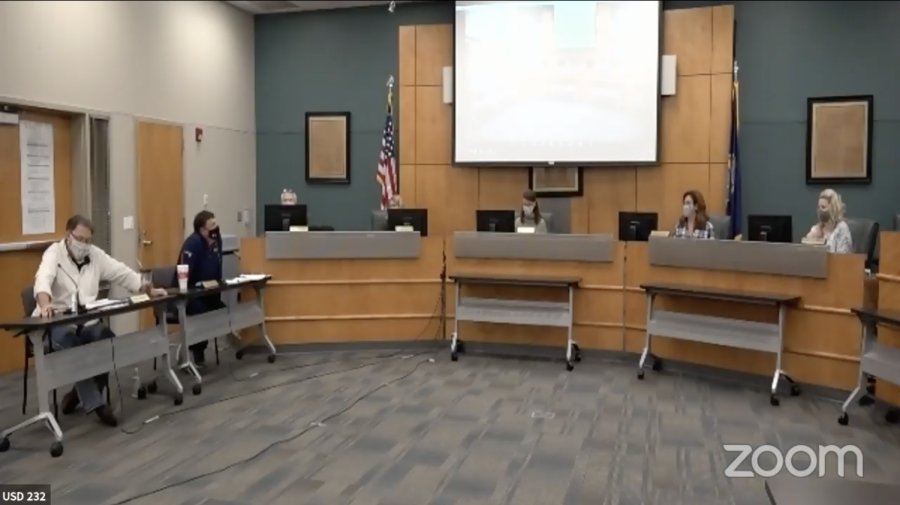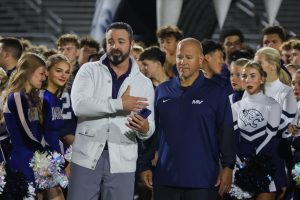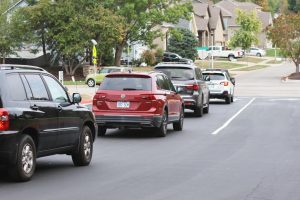Board votes 4-3 in favor of shift to remote learning for secondary students
The board considered staffing shortages and community COVID spread in their decision
By Ben Wieland
The school board meets to discuss pertinent issues.
November 16, 2020
After three hours of emotional deliberation, the school board voted 4-3 to approve a shift to the orange zone of the district’s gating criteria. Under the new guidelines, middle and high schools will move to a remote learning model beginning Nov. 30.
Superintendent Frank Harwood, speaking on behalf of the COVID advisory committee, shared the reasons for the committee’s recommendation to adopt the stricter guidelines: increased virus spread and staffing concerns.
“New cases and the positivity rate are increasing rapidly,” Harwood said. “The trends for staffing are alarming as the community spread of COVID continues to climb.”
According to data shared by Harwood, staff absences and vacancies nearly doubled from 326 in September to 602 in October. In the Nov. 9 school week alone, there were 213 new absences and vacancies — and 23 went unfilled by substitutes.
The board agreed that students and staff are following safety precautions — board member Rick Amos said that they “have done an unbelievable job” — but community spread made a shutdown inevitable.
“We actually think spread in schools is fairly light,” Harwood said. “The issue is that community spread is so high that we will have trouble keeping things running and keeping staff in schools.”
Board member Ashley Spaulding urged parents wishing for a return to in-person learning to follow safety guidelines and reduce community spread.
“As a community, we have to get our acts together. Our students and staff are doing so much to keep spread down. All of it is just for naught when we go home and parents are going to restaurants and gatherings inside houses with huge groups of people,” Spaulding said. “I am imploring our community — we have to work together to prioritize in-person education. That means getting this community spread under control.”
The decision was not unanimous — board member Bill Fletcher urged the district to remain open until enough teachers were either infected or quarantined to make staffing the schools impossible. His calls to keep the schools open by any means necessary were echoed by parents during the patron input session.
“It is not your job to take care of the community,” one parent said. “We need to go and go and go until the entire school has COVID.”
Parents also asked the board to “take the power back” from the advisory board and urged them to stop using their data to make decisions. One argued that “we need to learn to live with the virus.”
DHS student body president Brent Smith also asked the board to keep students in school.
“I don’t think COVID is spreading in the schools at all,” Smith said. “Closing schools will not have any major effects on keeping students and staff healthy.”
Spaulding addressed community concerns about the board’s decision-making, noting that the board makes an effort to consider the data and needs of all students.
“We are not acting out of fear,” Spaulding said. “We are following the gating criteria, and using the best information we have to make our decision tonight.”
The board ultimately opted to follow the recommendation of their advisory committee and the gating criteria they adopted at a September board meeting. Amos shared his thoughts on following the recommendation and expressed optimism that, if community spread declines, in-person learning could return in January.
“We created gating criteria that we selected to follow. We created a committee to advise us, because none of us are experts. While there is no right decision, for me it comes down to staffing and being able to educate our kids,” Amos said. “If going remote gives us an opportunity to get our ducks in order, and if the kids and staff and parents can get through it for three weeks and enjoy the holidays, hopefully we can get back in the classroom in January.”
In Harwood’s presentation on the committee’s recommendation, he also shared new data on mental health and academic performance from the first quarter.
On mental health, Harwood provided the results of the district’s yearly Social and Emotional Character Development survey, which he called “the closest thing we have to a quantifiable mental health metric.”
The data on mental health revealed promising results, according to Harwood.
“The questions we asked about mental health showed little to no change from previous years,” Harwood said. “If there was a significant change, it was in a positive direction.”
The information he shared on first-quarter grades, though, was less promising: the rate of Ds and Fs for middle and high school students has sharply spiked this year.
“There is a large increase in both the number of students receiving Ds and Fs and the total number of D and F grades.” Harwood said. “Students that do well are continuing to do very well. We are seeing more students towards the middle sliding down.”
The district will consider measures in schools to improve grades. Harwood added that grade issues are not unique to USD 232, and board member Danielle Heikes made sure to note that teachers and educators are working hard with students to improve their grades.
“Our teachers do a phenomenal job of doing everything in their power to help high-risk students with Ds and Fs,” Heikes said. “They work very, very tediously with our students.”
The board considered this data on community spread, mental health and student grades, deliberating for over an hour before coming to a final decision. The decision ultimately came down to staffing concerns and a desire to follow the gating criteria.
“If we really care about the students and their learning, we need to see that their current teachers and staff can continue to work,” board member Stephanie Makalous said.
No changes were made to the elementary learning model.
The board’s next meeting is scheduled for Monday, Dec. 7.









